The OnePlus One Review
by Joshua Ho on November 19, 2014 8:00 AM EST- Posted in
- Smartphones
- Android
- Mobile
- OnePlus
Battery Life
At this point, battery life is one of the number one priorities for a phone. While in 2013 our primary tests consisted of the web browsing test and video playback tests, we've expanded our suite to include Basemark OS II and GFXBench to simulate intensive general usage and gaming, respectively. For all of our tests in which the display is on, we calibrate the brightness of full white to be 200 nits in order to standardize and attempt to control for extraneous variables as much as possible. While this may seem arbitrary, it's important to do so to draw real conclusions about which phone has better battery life. 200 nits on a phone can be as low as 50% and as high as 90%, so setting a standardized brightness percentage would not be an effective method of controlling for display brightness. With that in mind, let's get to the battery life tests.

Here, we see that the OnePlus One takes the number three spot for battery life amongst phones and phablets. This is definitely a great result to start with, and is a solid 20% higher than the One (M8). However, the Huawei Ascend Mate 2 continues to hold its position with a long lead over just about anything else available in the market today.
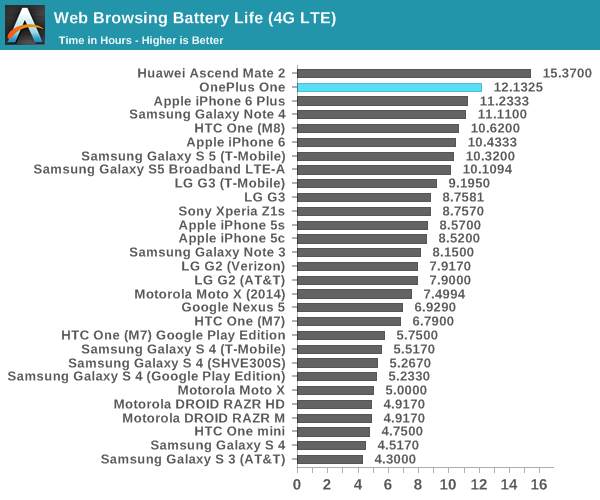
We can see a similar story in LTE web browsing battery life. However, the OnePlus One manages to close up the lead that the Ascend Mate 2 holds in WiFi browsing. It's likely that the 28nm LP process and lack of envelope tracker is responsible for closing the gap in this regard. It's interesting to see how the iPhone 6 Plus trails behind the OnePlus One here, but it's likely that this difference is due to the fact that the iPhone 6 Plus has an off-die modem compared to the OnePlus One's on-die modem.
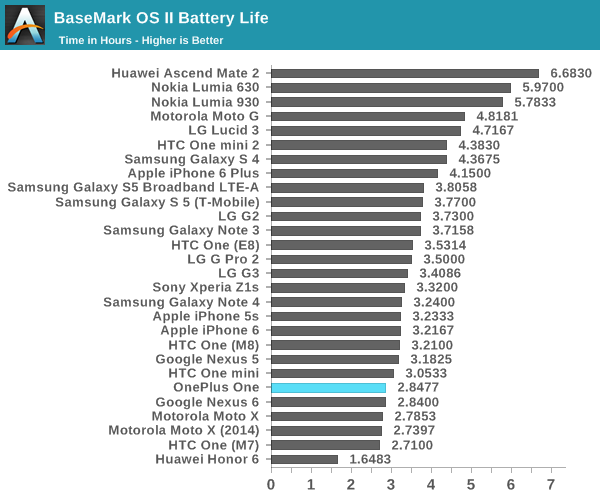

White battery life tends to fall towards the bottom here, we can see that the reality is that the OnePlus One performs quite well, which indicates that there's relatively little throttling to speak of and that the OnePlus One is simply doing well by sustaining high levels of performance.
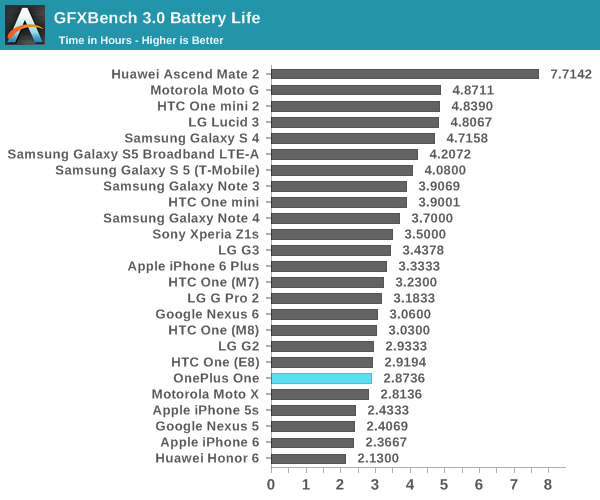
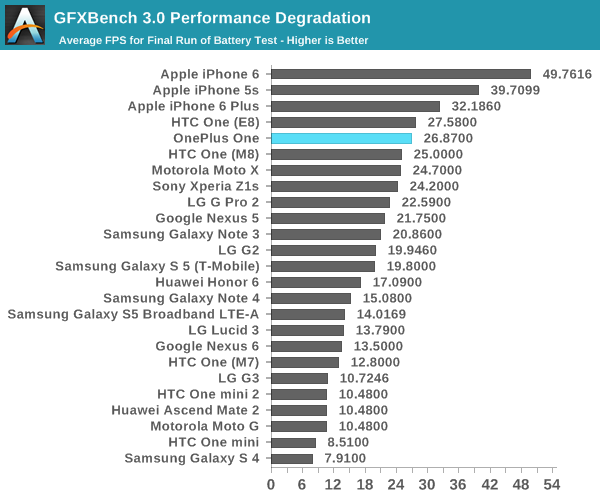
We see the same story in the GFXBench rundown. The OnePlus One manages to set a new record for final run FPS among phones and phablets, although battery life is near the bottom of the pack. It seems that if there's any one reason for the escalating display size wars, it is to increase battery life. While by no means a clear order, we can see that the larger battery more than compensates for the larger display of the OnePlus One. This makes sense, as a phone should have a fixed size circuit board. Therefore, by increasing display size the circuit boards become smaller relative to the rest of the phone, and all of the area opened up by increasing the size of the phone can be taken up by the battery. Overall, the OnePlus One is almost as good as it gets for battery life in a phone, with excellent sustained performance under load.
Charge Time
To really have a holistic understanding of battery life, we must also take a look at charge time. While battery life can be the only determinant of mobility, in cases where usage is heavy enough that the battery or multiple batteries have to be charged, charge time can become incredibly important. To this end, OnePlus includes a 5V, 2.1A charger in the box to quickly charge the rather large 11.78 WHr battery.
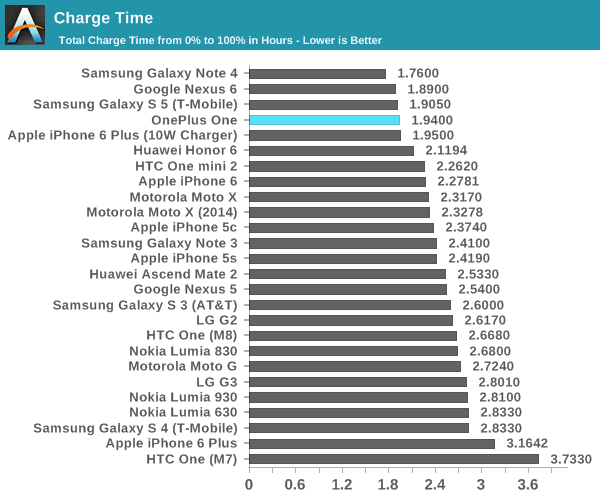
Somewhat surprisingly, the OnePlus One does a great job in this test, coming quite close to other devices with QC 2.0 fast chargers like the Galaxy Note 4 which is definitely good to see. Overall, this makes the OnePlus One one of the best phablets on the market for battery life.










148 Comments
View All Comments
MadDuffy - Wednesday, November 19, 2014 - link
Thanks for your review.Some corrections on page one specs: MHL not supported and BT 4.0 (not 4.1).
anneoneamouse - Wednesday, November 19, 2014 - link
"Reception, at least for T-Mobile US' band 4/AWS LTE is noticeably worse than most devices that I've tried."This would seem to be a significant issue; yet this one-line detail is buried under the "misc" section, and not discussed in the conclusions at all. Three pages are devoted to analysis and discussion of photo / video quality, which for most users are likely to be secondary functions.
It's a phone; can I use it to speak clearly to a client? If not, I'll look elsewhere.
AoN.
DoktorSleepless - Wednesday, November 19, 2014 - link
Yes, this needs some serious elaboration.Cinnabuns - Wednesday, November 19, 2014 - link
I agree. Especially with all the praise and in-depth look given to the Moto X's cellular reception on this site, it would be helpful if all phones reviewed had a small section describing its reception characteristics.Harry_Wild - Thursday, November 20, 2014 - link
As a T-Mobile customer; this reception quality is top priority for picking a phone! LTE is for most data until T-Mobile changes it to Voice over Internet using LTE band. But that will be in middle 2015 and later.It not a hardware problem; it a software problem so One Plus should be able to fix it with T-Mobile's assistance.
Conficio - Friday, November 21, 2014 - link
@Harry, how come you are sure this is a software issue. Could be bad placement of the antenna or bad antenna design in general. Also, I think we don't know if the issue is limited to T-Mobile. That was just the network he tested it on.You make a good point though, if this is an LTE issue (which the article does not say), then in 2015 this phone on T-Mobile goes from good voice and bad data to issues for both.
More questions: There were software updates mentioned. Did those affect the reception issues? And did they swap out the baseband?
Conficio - Friday, November 21, 2014 - link
That also made me really nervous. I'm a T-Mobile customer and really need to know how he did notice this. I have seen some good cellular comparison tests in the past on Anandtech. Please lets get some objective comparison or at least some more detail on how this does effect the phone? Indoors, outdoors, calls dropped or not starting, get no reception where other phones have reception. Any reaction by the company?Munna2002 - Friday, November 21, 2014 - link
I am a T-Mobile customer with an OPO. My family also all use OPOs. We have no problems with LTE speeds in the NYC Metro area, although we do not have the T-Mobile Wifi calling app, which requires messing with the bootloader and kernels from what I understand.jmasterj - Wednesday, November 19, 2014 - link
This review is missing an important section that always appeared in Klug's phone reviews: network performance. There's one anecdote about how it performed on T-Mobile's LTE, but nowhere are listed even the HSPA or LTE bands supported by this device. It would be nice to see testing in this area.pjcamp - Wednesday, November 19, 2014 - link
Since you took the time to review this vaporphone, perhaps you could also do the Xperia Z3?